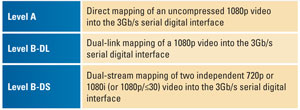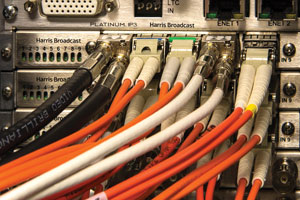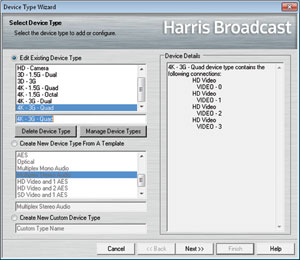Future-proofing plants and trucks
After many years, the transition to HDTV continues to roll out both domestically and worldwide. This major step in technology was the first wherein consumer industry products were capable of delivering higher-quality video than broadcasters were typically sending into the home.
Many broadcasters simply upconverted SD to get on-air for HD once digital transmission standards were settled for OTA, cable and satellite. Shooting in 16:9 fooled many viewers into thinking they were seeing HD. Certainly a full-digital 16:9 SD plant with a high-quality upconverter to HD creates stunning results, mainly due to never having encoded the video into NTSC or PAL analog domains. The switchover to digital bought broadcasters several years of avoiding expensive HD equipment upgrades.
As the technology shift continued, broadcast equipment manufacturers observed that camera sensors were being built for 1080p as a simpler method of making them selectable between 480i/576i SD and 720p/1080i HD resolutions through the use of internal processing algorithms. This foresight then drove the push toward building distribution and routing products to handle 1080p signals, as the feeling was that 1080p would ultimately become a driving force for display technology, too.
Today, 1080p is the norm for video quality in consumer products, with 3-D TV also in the mix. 4K sets are coming, but remain too far off for broadcasters to transmit anything beyond a few boutique channels — so let’s hold this thought for right now and focus on HD.
1.5Gb/s infrastructure
HDTV infrastructures that operate at 1.5Gb/s support 480i/576i SD and 720p/1080i HD resolutions. To get the best quality for the 1080 lines of resolution, progressive scanning and two SDI connections are required. This dual-link connection — basically two HD 1.5Gb/s streams — has been extensively used in small, high-quality production environments for 4:4:4, fill and key, and most recently for left- and right-eye channels. Broadcast system designers prefer a simpler, more cost-effective single connection, so until this was a possibility, higher-quality production for broadcasters was considered cost-prohibitive and too complex to implement.
To better support 1080p, broadcast equipment manufacturers collaborated with SMPTE to upgrade HD-SDI from 1.5Gb/s to 3Gb/s. By agreeing to move exclusively to 3Gb/s infrastructure products, equipment manufacturers were able to push integrated circuit manufacturers to supply 3Gb/s parts at the same price as 1.5Gb/s. This set the stage for future-proofing plants for 1080p (and also for 3-D TV), but has this small step brought home viewers any better quality than they have seen before? Well, not yet. The reason is that current conversion, bandwidth compression and display techniques use deinterlacing and scaling technologies that affect the end video quality.
So how do we improve quality? The infrastructure exists today to eliminate the need for deinterlacing and scalers, so why not just start with 1080p?
The professional video industry's #1 source for news, trends and product and tech information. Sign up below.
Interlace vs. progressive
There were two choices when HDTV infrastructures at 1.5Gb/s were built: 720p and 1080i. The two formats generated a huge debate and almost religious wars.
Interlace was certainly great back in the CRT days, but we have moved well beyond this. The benefits of progressive scan — whether 720p or 1080p — are huge when it comes to production, processing and compression. To keep within 1.5Gb/s, we were clipped at 720p for HD; however, with 3Gb/s, we can easily jump to 1080p. Flat-screen TV sets are all progressive scan on the display side. When the input is interlaced, the TV sets convert the signal into the set’s native display format with complex algorithms. This conversion causes artifacts because of the deinterlacing step required for progressive internal processing.
As the advent of 4K/Quad HD/UHDTV-1 leads us into the future, DVB and ATSC standards continue to evolve, incorporating 1080p and higher resolutions to keep pace with home display devices. However, unless a higher-quality video resolution becomes proven across the entire workflow, moving to 1080p over 3Gb/s infrastructures is the easiest and quickest step to improve broadcast video quality today.
3Gb/s infrastructure
With the birth of 3Gb/s, various technical issues arose that would take advantage of the extra bandwidth, yet still be compatible with systems limited to 1.5Gb/s. SMPTE standards were developed, describing three different mapping schemes for transporting uncompressed video including ancillary data such as the audio data, the audio control packets, the payload ID, the time code, etc., into this new SDI interface running at 3Gb/s. These are defined as Level A, Level B Dual Link (B-DL) and Level B Dual Stream (B-DS). (See Table 1.)

Table 1. 3Gb/s has three different mapping schemes.
Level A carries one 1080p video signal. Level B-DL is formatted in the same manner as described above for building larger, more cost-effective, high-quality production systems. Level B-DS is able to carry either two different 720p or 1080i signals, or one left and right frame-aligned pair of 3-D TV signals running at 720p or 1080i.
Although these mapping schemes appear straightforward, it is important to ensure the streams are properly tagged, as many devices are not compatible with all three levels. Additionally, we can’t forget about the embedded audio streams, especially in Level B modes. Be sure you know which streams you are actually using and modifying.
Cabling
Cabling is also an important consideration. In SD infrastructures, cable lengths over 400m are typical. 1.5Gb/s infrastructures have a shorter length of typically 150m, with the latest technology providing up to almost 300m. For 3Gb/s, the length is typically 80m, with a maximum 180m made possible by using the latest technology. These cable lengths are dependent on the cable type and equalizer technology.
Fiber-optic technology is used when longer cable runs are required in a 1080p plant. Fiber is often thought to be highly complex, but this is far from the truth. IT usage of fiber has advanced the technology, and broadcast can tag on these improvements.
Additionally, a technology called small form-factor pluggable (SFP) now allows for deciding on-the-fly whether ports on routing switchers will use optical fiber or coax cabling. In this mixed-mode environment, both optical fiber and coaxial-type interfaces are used depending on the system design, which is typically decided on cable length requirements. (See Figure 1.)

Figure 1. Small form-factor pluggable (SFP) technology allows for mixed-mode operation of both coax and optical fiber in large 3Gb/s routing switchers.
For future-proofing plants, 3Gb/s certainly does the trick, and many infrastructure products are 3Gb/s-ready now. Some simply need software upgrades and have device control parameters set for various uses. (See Figure 2.) Notice for 3-D TV, there are a couple of options to bind inputs and outputs together depending if running dual stream or combined. For future 4K considerations, different options are available for binding together two (dual) or four (quad) ports for different 4K frame rate options.

Figure 2. New 3Gb/s routers are future-proofed for new standards such as 1080p and 4K with drop-down configuration menus.
In summary, moving to higher quality across the baseband workflow is possible today by using image formats such as 1080p. Building a plant based on 3Gb/s infrastructure products is a cost-effective way to keep your facility up to date. By eliminating the video scaling and deinterlacing technologies that cause artifacts in the video image before distribution into the home environment, broadcasters can follow the price curves of IT fiber-optical technologies, future-proofing their facilities with 3Gb/s and bringing higher quality into the home.
—Stan Moote is VP Business Development, Harris Broadcast, and Randy Conrod is Product Manager — Digital Products, Harris Broadcast.
